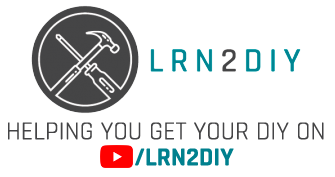With home ownership comes home repairs. Here are some helpful tips and information to help you with important home repairs.
5 Monthly Maintenance Tasks New Homeowners Should Do
Common Mistakes To Avoid With Your HVAC System
Important Components For Your Network Connection
I’m Nils with learn to DIY. Sometimes, bad damage can happen to your drywall. I’m going to cover all types of damage, and show you how to fix just about every hole that you’ll find in drywall, and they will fall into one of four types.
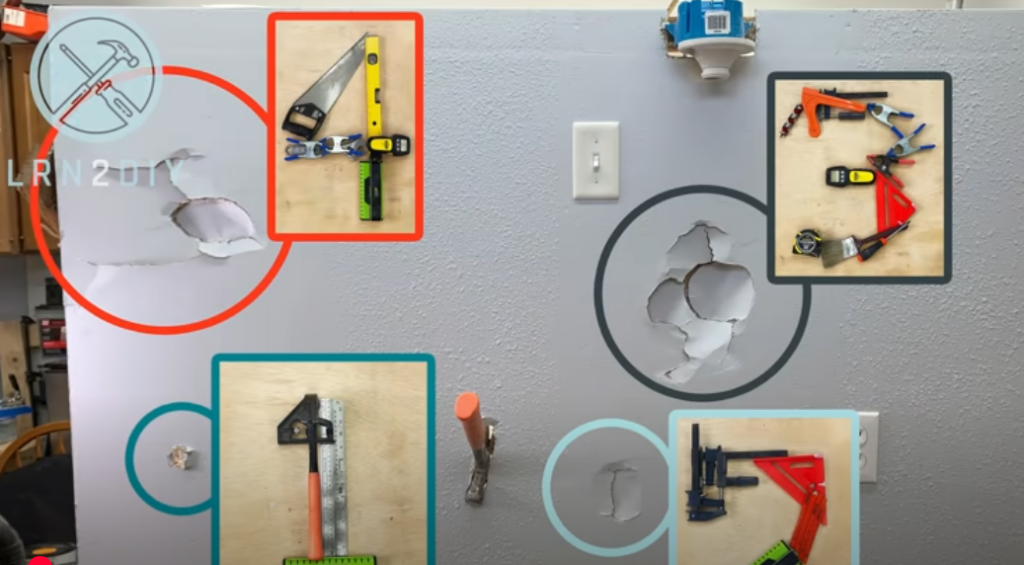
Small Hole Repairs
You’ve got something that’s really small, like an inch to an inch and a half or smaller, maybe that’s two and a half to three centimeters. That’s something that we can patch a certain way.
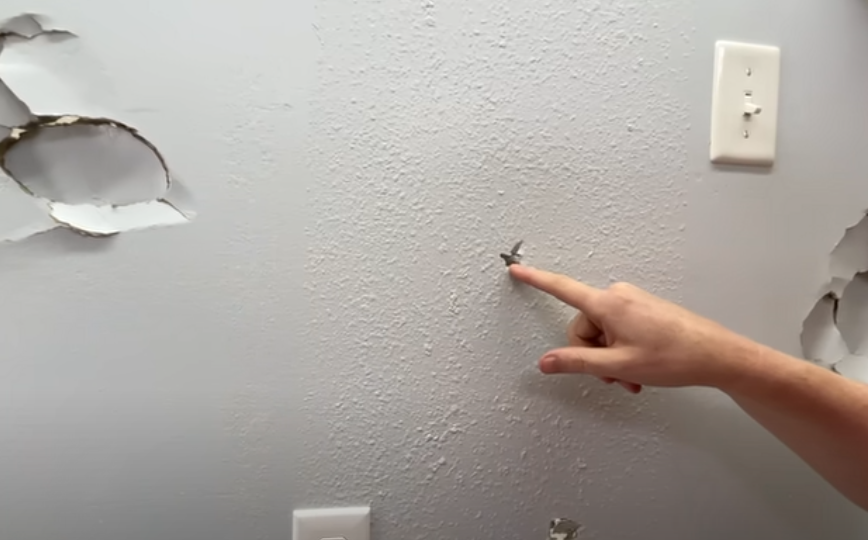
Fist-Sized Hole Repairs
Up from there, you got anything that is about fist size, four or five inches. From there, you’ve got something big enough that it’s in between your studs, or maybe it’s even over a stud, but it needs some support. So we are looking at damage in the range of seven to nine inches.
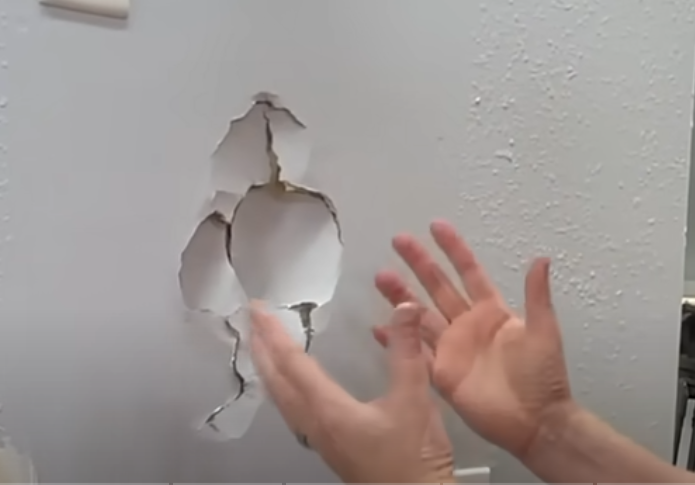
Larger Hole Repairs
And then lastly, we’ve got some major damage, and this will need to have a whole section replaced. Those are the four types we’re going to cover. I’ll show you the best and quickest way to handle each of those. I’ll show you how to match the texture and make it look smooth, just like the wall was before it was damaged, even if you’ve got orange peel, Santa Fe, Knock down, or a completely smooth wall.
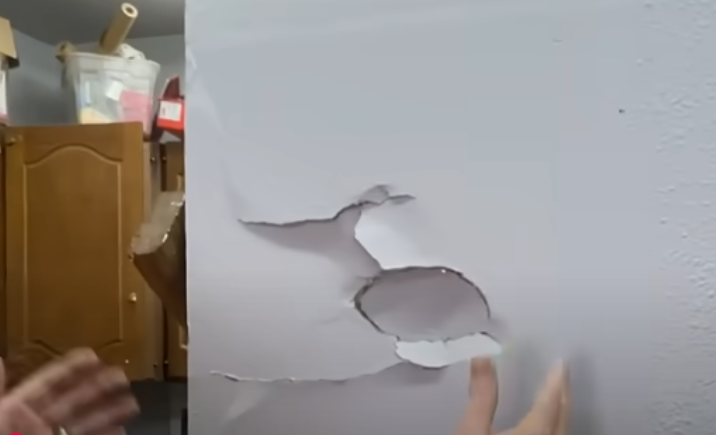
We have 2 small holes. One is about an inch, and with something like that, anything that is about an inch or so, maybe two and a half centimeters or smaller, you can patch that with mud. You don’t need tape or a patch kit. You can use those things, but they’re not going to help a whole lot because it’s such a small hole. It should be easy enough to work with.
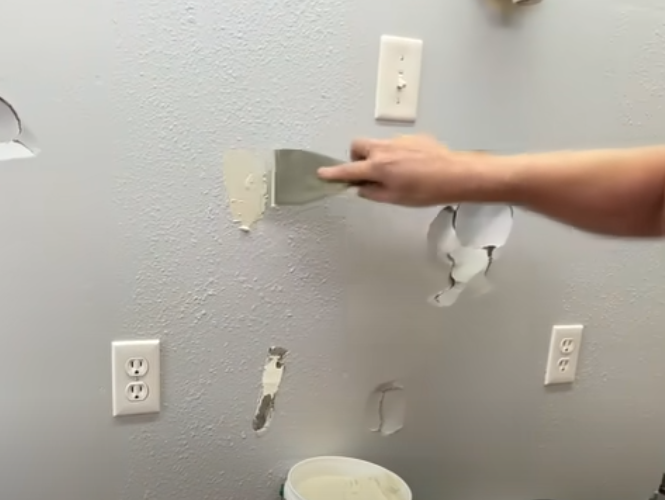
What works best is to take some mud that you get at the store. You can buy this in a larger bucket for about six dollars, it is fairly inexpensive. You can also buy powder that you mix up yourself, or you can buy a small container of mud that will be enough for a small hole.

I recommend using a putty knife that’s at least three or four inches in width. And with the knife like that, a mud knife, you’re going to fill in that hole as best as you can. You want to be pretty generous in pushing that mud back into that hole to make sure that it’s backfilled and there’s plenty in there so that it’s nice and strong when it dries. On the first coat, you’re going to have some bubbling. It will bulge out a little bit. It’s not going to want to stay in place well, and that’s okay. We’re going to put that in there as best as we can to cover it up, and then we’ll let that sit.
For the fist-sized hole, there are a few ways that you can tackle this. I’ll show you all three, and two of them are very similar. With the first one, I use a large mesh adhesive patch. I can just apply this eight-by-eight patch over the whole thing. And the goal here is really simple. I’m going to clean up the edges, make sure it looks good, and then smooth the patch out as best as I can, making sure there are no creases, wrinkles, or any issues with that patch, and it’s nice and smooth.
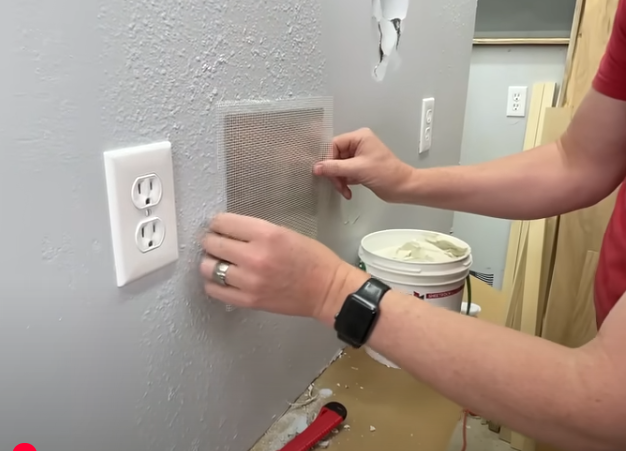
Next I will take the mud and fill that in and push a lot of that mud into the area that has the hole in it. And you can see from the back here, when you push mud in through these patches like this, it’s kind of a Play Doh Fun Factory effect, and that’s what we want. We wanna get a lot of that back there to rebuild that drywall that’s back behind there.
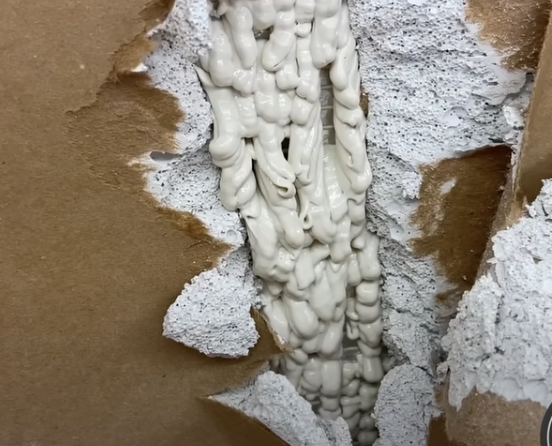
And once I’ve got that filled in really nicely through the area behind the patch, I’m going to cover up the whole patch itself using that same knife. The goal is to get it nice and clean, it doesn’t have to be perfect. You want it to look really good and cover up everything that’s there. This is option number one for the first coat.
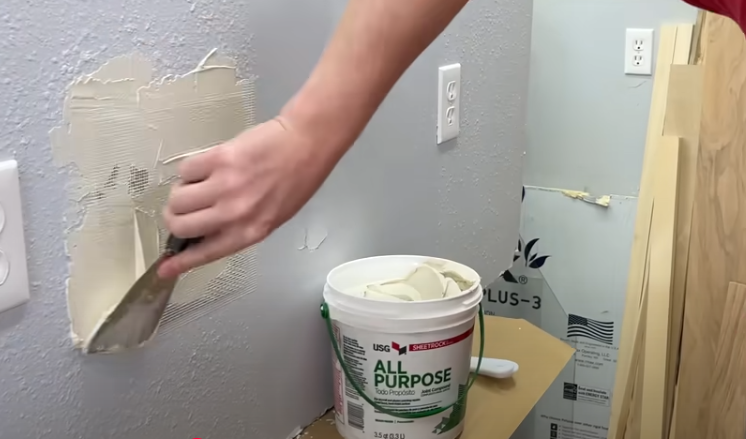
Option number two is called the Presto patch. The Presto patch is a straightforward idea. It’s a four-inch circle of half-inch drywall, and then it has a larger section of paper that we’ll use to blend with the surrounding wall. So the idea with this one is you take the styrofoam that came with it, it’s a template. You trace out your template with a pencil, and then cut that out with a knife until that circle is just the right size to match that presto patch.
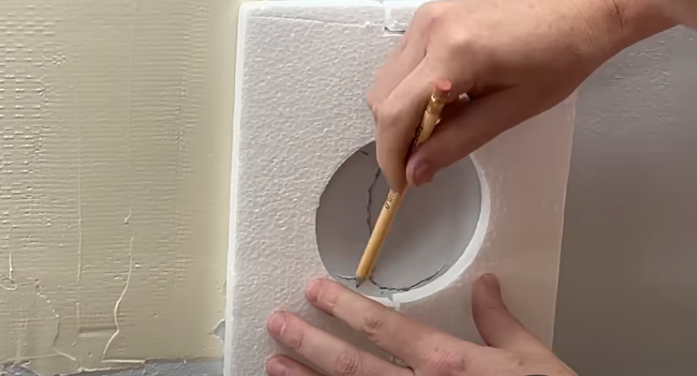
Once we’ve got the circle cut out, I’m going to apply mud all around the inside of the circle, as best as I can, and then I’ll apply it around the outside of the circle where the paper goes. Then I will apply it to the plug itself. I’ll be applying the mud liberally to the patch itself, especially on the top of the circle where gravity will have pulled it down from the hole in the wall, and then we’re going to push that in.
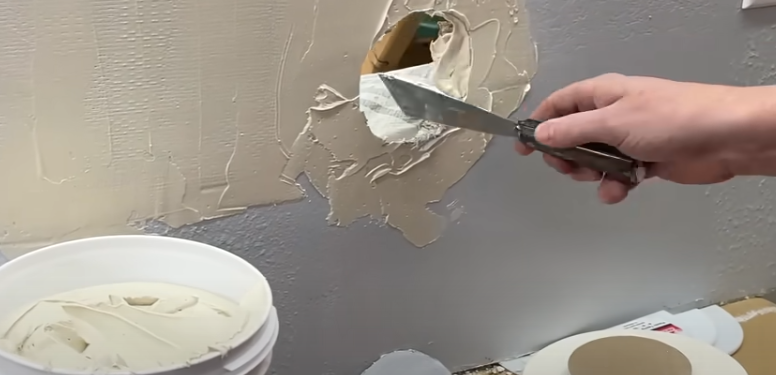
I’m going to use a knife to pull across and pull from the center outward, and I’m going to smooth all of that mud out from underneath the paper to get that nice and smooth. This will match up with the contour of the wall, just like it was before. I will cover it enough so that it’s covering everything and I’ll have nothing peeking through. I don’t want it so heavy that it’s going to take two years to dry, or I’ll have to sand for eternity.
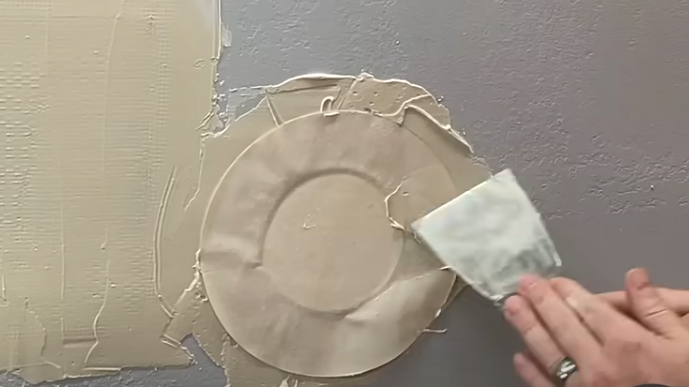
The third technique to fix a hole in the drywall that can be used for a hole this size is called a California patch. I will be doing the same thing that we saw with the Presto patch, but this time, I am cutting my own out of drywall. I will cut out a square as big as it needs to be to get a good, strong drywall all around it. Anything that’s been roughed up or broken, especially on that backside, I will cut that out and make that square as big as it needs to be, to where I will have good, solid drywall there.
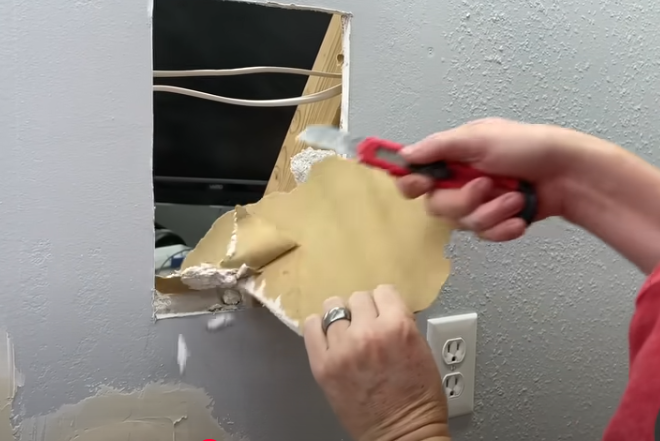
I’m using a square to clean up my edges and to make sure that it looks decent. I’m going to use a piece of drywall that is about an inch and a half bigger on all sides than the square. So let’s say this was a five-by-five. Then I would cut a piece of drywall that’s about eight by eight. That leaves us with that inch and a half all the way around. Now, once you’ve got that piece, you can hold the piece right up to the wall, use your knife to score a line down one side and down the inside. That’s just a little bit smaller than the hole.
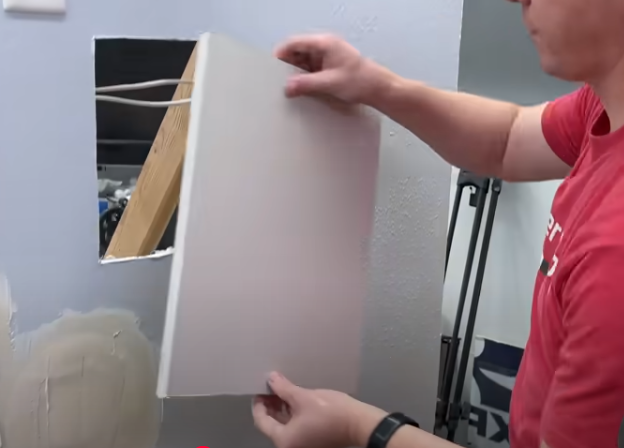
Now I will flip it to the other side for the height and do the same thing. We’re going to have that square in the middle that’s going to stay there and end up being our plug. From there, you’re going to snap off, and then you’re going to peel everything but that front paper off, so you’re going to get all the gypsum and that back paper removed on all four sides. I will end up with a plug like this, which is similar to the Presto patch, but one that we made ourselves.
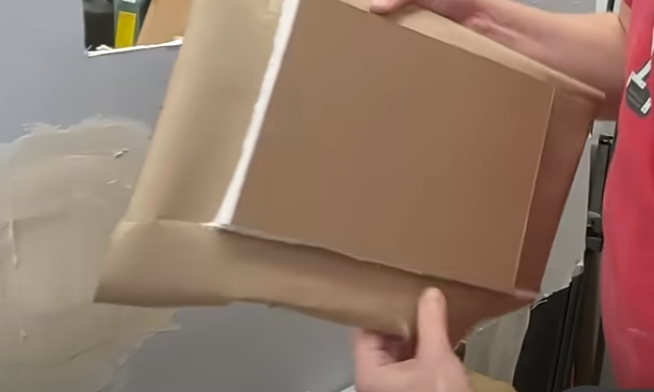
The technique is exactly like what we showed with the Presto patch. I will line the outside and the inside of the hole with mud. I’m going to line mud all over the inside of the patch itself and then push that in after I’ve got the right fit and we’ve dry fitted it to make sure it works. I will smooth out all the mud from the paper, and then cover the whole thing in its first coat.
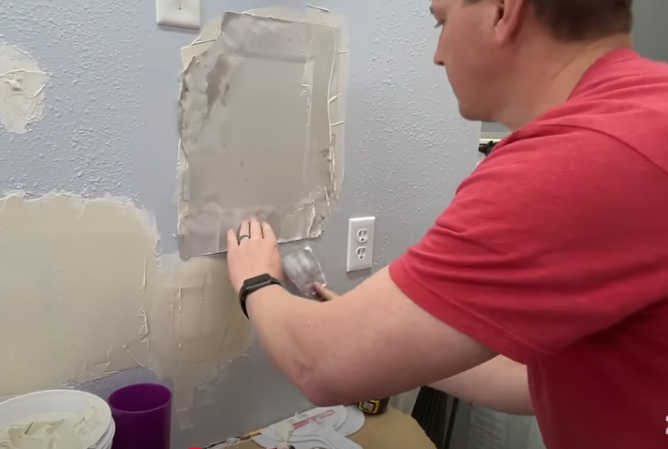
The only difference between the second type of hole and the third type of hole in your drywall is the backing. If it’s any bigger than fist size, I would recommend that you put some backer boards on it. This technique is really simple. I just need a couple of scraps of wood. Could be anything. Plywood works well because it doesn’t split easily, you can use leftover MDF, some trim, just some one by pine that you have lying around. Anything will work pretty well. What I want to do is cut it so that it extends out a couple of inches past the width of the hole on both sides or the height, whichever way you want to go. It doesn’t matter if you put these horizontally or vertically, but the goal is to provide four corners for the patch to screw into, and then those four corners are supported by screws into the drywall around it.

Now I will drive some screws into these boards. I’m going to drive them right into the board and have that pucker the board right up tight against the drywall. Once I’ve got those two boards in, I end up with a nice area and some support for my patch to go in. A fix like this can go fairly large on this. If you’ve got a 10-inch hole, for example, then it can cover something like that easily, as long as you’ve got that support and you’ve cleaned up your square and you’ve made sure that you’ve got good drywall to work with. What I don’t want to do is go skimpy on the size of the hole that you cut for this, and then have a weak drywall to work with around it, because this depends on the strength of the drywall surrounding the hole that you’ve cut out.
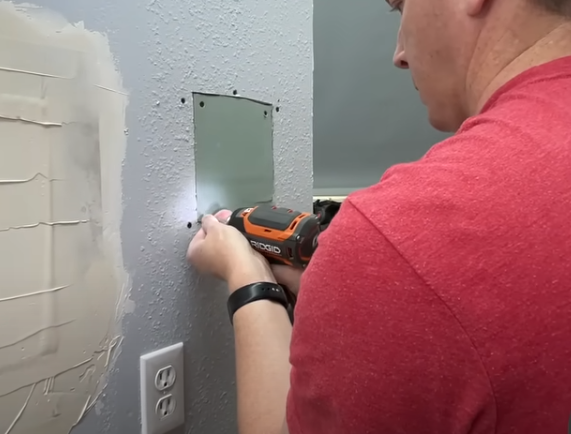
Large Hole Repair (Stud to Stud)
The fourth type of hole is the largest one. That’s where there has been a lot of damage. Possibly someone’s body checked the whole wall, or got thrown into it, and you’ve got a large amount of damage. What I would recommend doing every time is cutting it out from stud to stud. Use a stud finder that you can rely on to find exactly where the studs are, and then I’m going to mark those on my wall. Once you have those studs marked, you can use a jab saw, or a drywall saw. You can also use a knife for this, or a box cutter like I have been using. A jab saw makes quick work of this. And we’re going to cut from stud to stud.

I’m going to cut right down along the inside of the two studs where I’ve been working. Now that I know exactly where the inside of the studs are, I want to come over about three-quarters of an inch, or half the thickness of the stud, and I’m going to use a knife to open that section up. The goal here is to have a lip or a secure area for the new piece of drywall to sit on. I’m going to have a span from stud to stud, and I will then be able to use those studs to fasten and hold in place well.
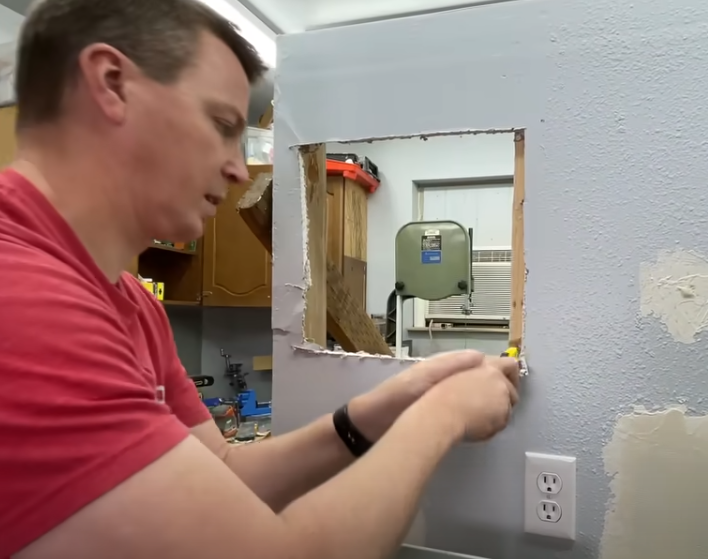
Just like with the California patch, I could create a large California patch here to fit in this area, but I’m going to show you how to do this with mesh tape instead. Mesh Tape is a very common method for a larger area like this. I’m going to fasten this new piece in and use drywall screws and drive it in. I’m going to apply some of this yellow adhesive mesh tape. I will apply one piece on each side, trying not to overlap because that adds to the thickness of the covering that we have to do. And then use your knife to tear it because it makes a nice straight line. It’s easy to work with.
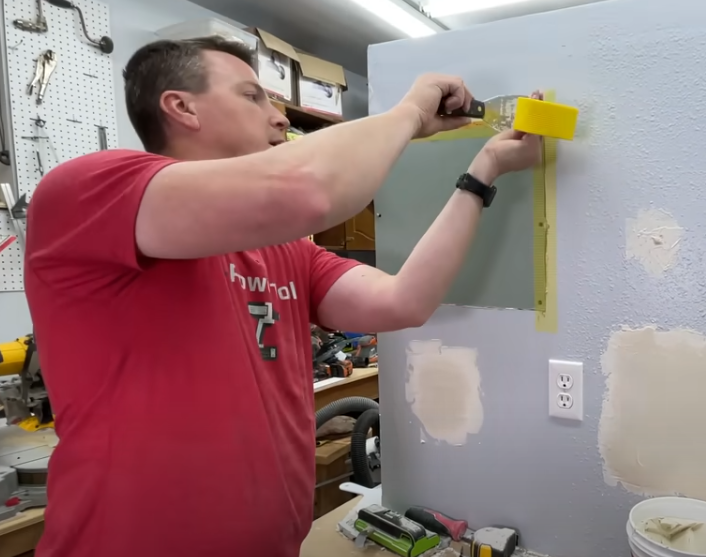
Once I’ve got all four sides covered up, I will apply mud just like before, into those seams. I’m going to push that in. And from the back, you can see what this looks like. I’m pushing that mud thick into that area to try to cover as much of that half-inch section or five-eighths-inch section as we can. I’m going to cover this up so that I can’t see the tape anymore. Again, it doesn’t have to be perfect on the first coat. I’m going to do my best to get it nice and covered. I’ll come back the next day, and then I can sand this.
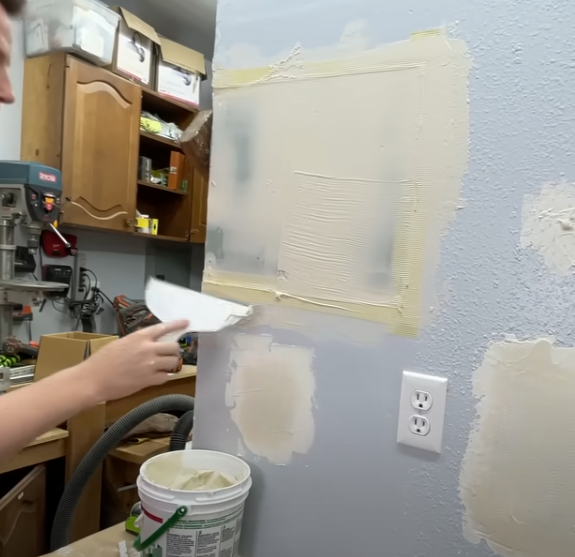
For sanding, I used a hand sanded sponge, or you can do this with an orbital sander, or a palm sander if you have one. Make sure to wear proper respiration. This is going to kick up a lot of dust, so make sure that your lungs are protected. I would recommend some goggles or safety glasses as well.
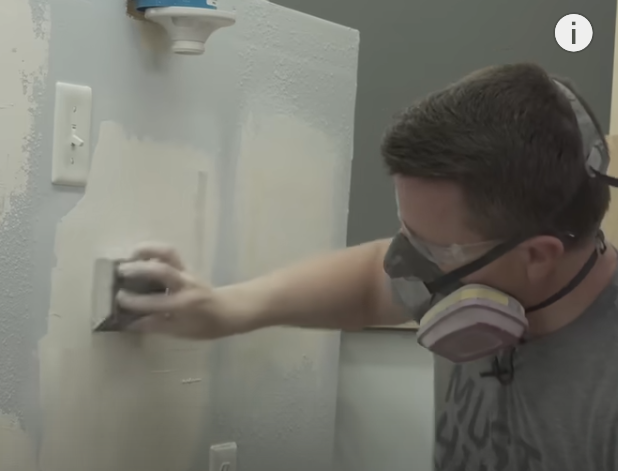
For the second coat, I will use a larger knife and cover it up and smooth everything over after it’s been sanded. I’ll put that second coat on, which is called a skim coat. I recommend mixing up some water in a pan. So I use a mud pan; if you don’t have one, then use something similar to it. Mud pans are awesome because they have a blade on either side to scrape the extra mud off, and it gives a nice clean blade every time I use it, or a nice clean knife.
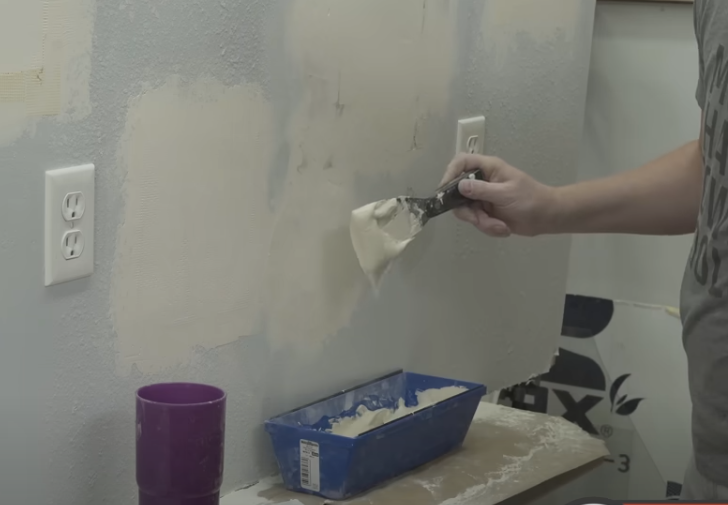
I’m going to skim across here to get this nice and covered, and hopefully it ends up with a pretty smooth finish. Now, depending on whether you’re working with a knockdown style or Santa Fe style texture on your wall, versus an orange peel, you might end up with some high spots and low spots and things like that. But again, the goal is to get it as smooth as we can.
Feather on that outside, and along the top and the bottom, creating a nice, smooth transition.
Then I do one down the middle, and that makes all the difference.
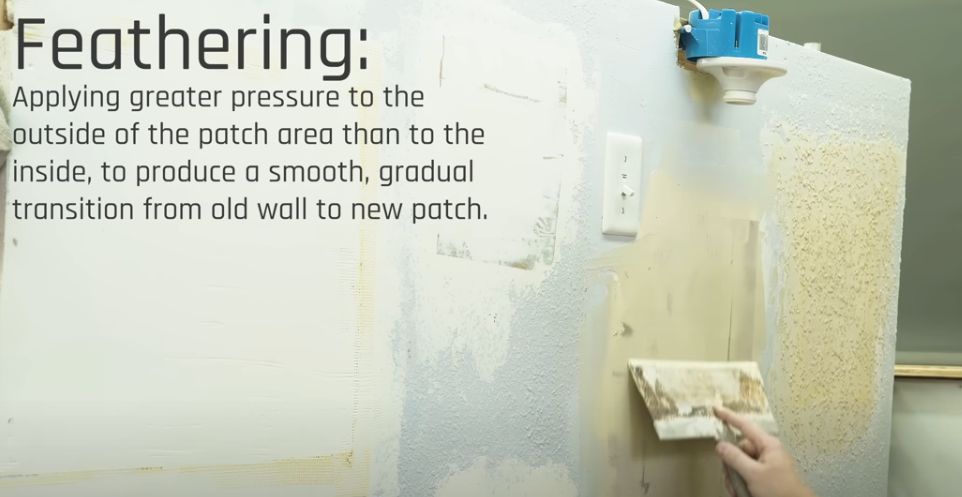
Having a good blade does help. So if you can get one, they are pretty inexpensive. They’re usually around 10 bucks for a metal blade. I’ve been using this one for years, and it works well. Depending on how that second coat goes, you might need to come back and sand it and add a third coat. If it’s looking good at that second coat, and you’re ready to place texture.
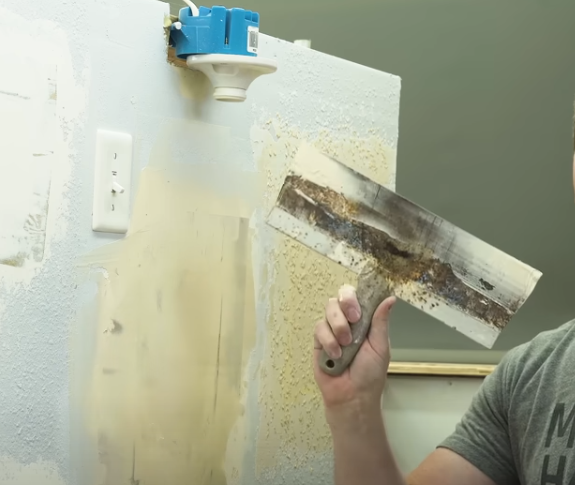
Adding Texture To Your Wall
No matter what size the patch was that we had to take care of on the wall, you will want to use something that matches the texture afterward. If you’ve got an orange peel texture on your wall, and you finish it smooth, it’s going to look like it was patched. Same with if you do the opposite. Now, they do sell different textures that you can purchase. You can buy these online, and I’ll put links in the description below. They come in different-sized cans, and there are different ways to do it. I’ll put some of my favorites, and then you can also stop at the local hardware store and pick up this wall texture in a can. They’ve got orange peel like you see here, and they also have a knockdown variety.
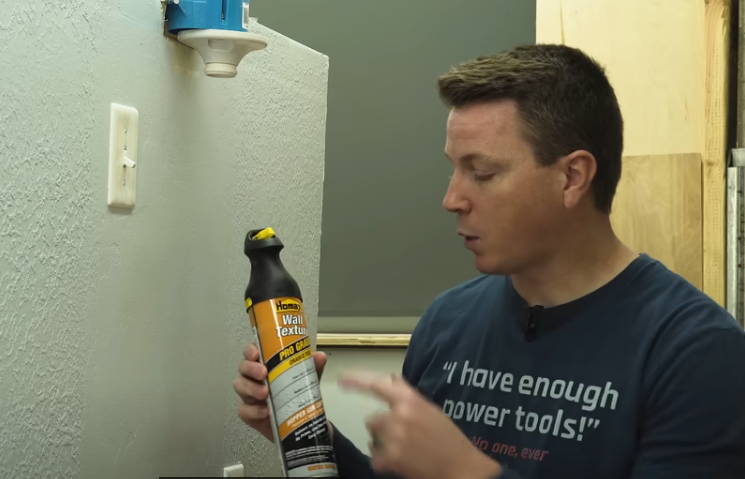
With the texture cans, they have different settings. You can move this tab from side to side to adjust the pressure that it sprays, and then you can twist a knob to adjust the coarseness or fineness of the spray. You might want to experiment on a piece of cardboard or an unseen area so that you’re not trying this out for the first time on your actual wall. Spray it in a circular motion. I’ll cover that up, and then end up with a decent matching orange peel texture.
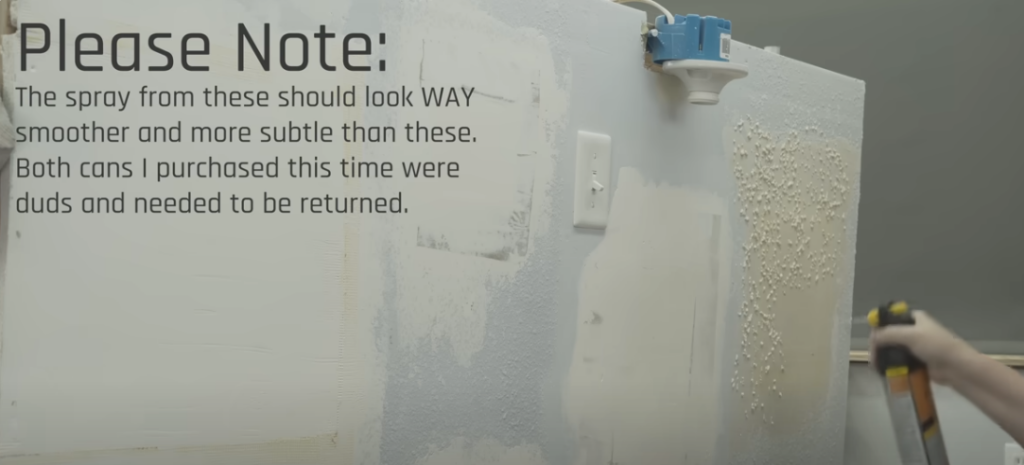
If you don’t have orange peel, but have something more like the Santa Fe or knock down texture, and you can recognize that by how some areas are raised and some are lowered. It looks kind of like this kind of Euro texture going on to it. It’s very traditional. It’s been around for a long time. So if you have that texture, you can also buy some knock-down texture in a can. You’re going to spray it in a kind of random pattern around the area that needs to be treated. And then you’re going to use a 10 or 12-inch knife and pull across it evenly. And your goal is to leave this as smoothly as possible. You don’t want any little streaks or cuts or scrape marks in there or anything like that, because this is kind of the final coat that you’re going to be doing.

If you don’t want to use the can, you can also do this by hand with some mud. Dab some mud on here in different areas, kind of randomly. Make sure that it doesn’t look like it’s in rows or lines or anything like that. So keep that as random as possible. And then, just like before, you’re going to take your 10 or 12-inch knife and pull it across, go in various directions if you need to, to try to get that nice, smooth finish to it. And if you have a good blade, a metal blade makes it so much easier. I’ve tried this with the plastic ones, and they don’t do very well, but with that metal blade, you can pull that across and get a really good texture. And your goal is to leave some of the areas a little lower, some a little higher, so you have that knock-down or Santa Fe look to it. The last thing to do is just paint.
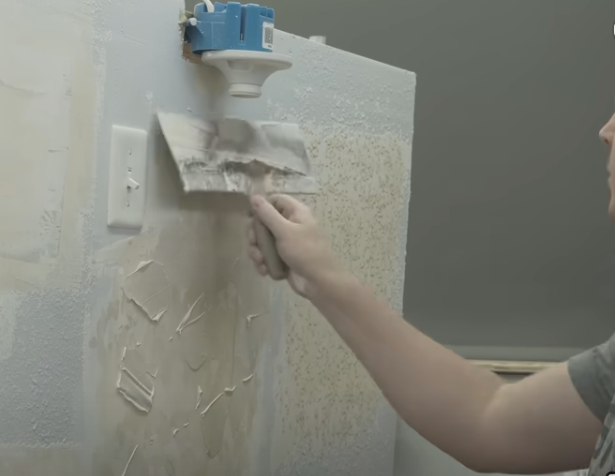
Painting Your Finished Wall
Make sure that you get all of the dust off there. This stuff can be porous. It can soak up a lot of paint, and you don’t want to end up with dust on your roller while you’re doing this. This wall that was full of holes just a couple of days ago is now patched up and looks good. One tool that was helpful on these larger patches is a good stud finder. Knowing exactly where that stud is, having an accurate representation of that, I did a video a little while ago on several different stud finders. I compared them and did the stud finder showdown.
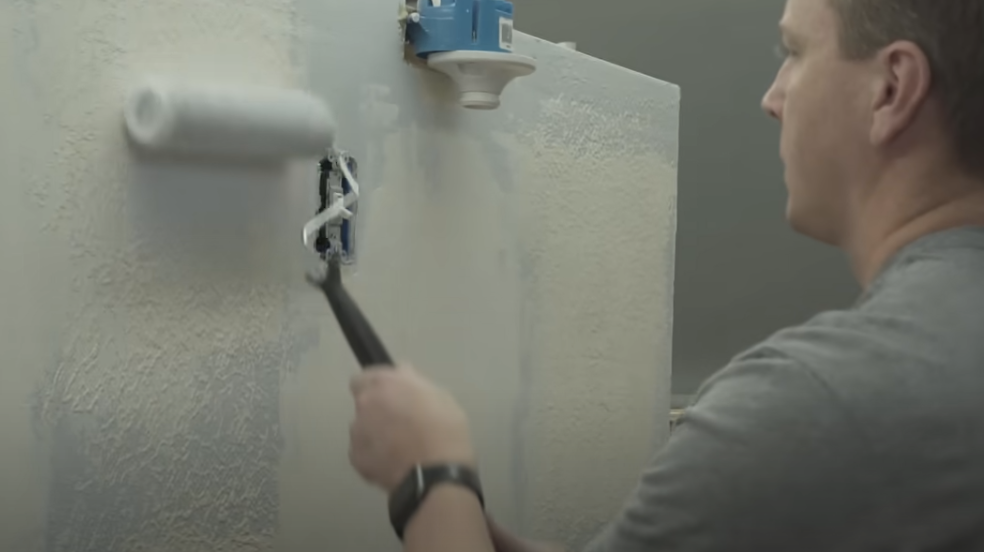
Don’t throw out the idea of purchasing an older home. I have a post on Common Fixable Problems with Older Homes. Click HERE to learn more.
I can show you how to install an updated Electrical Sub Panel for DIYers and save thousands of Dollars. Click HERE for all the info.
